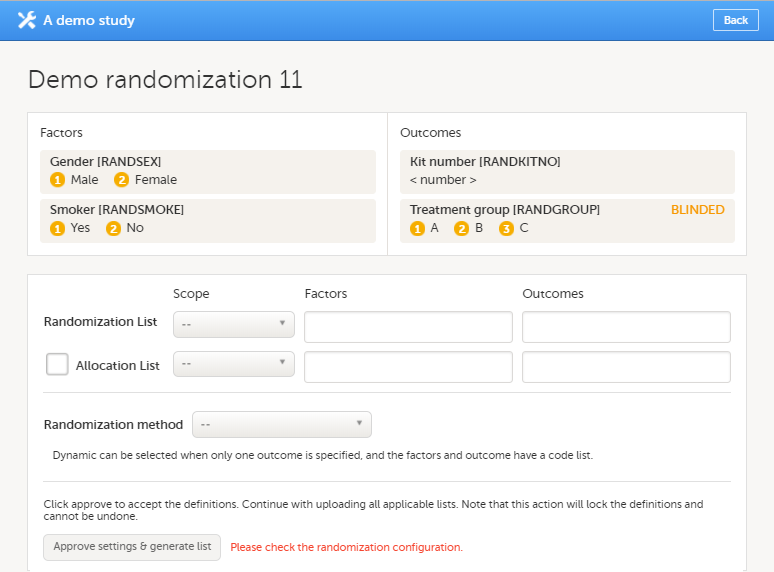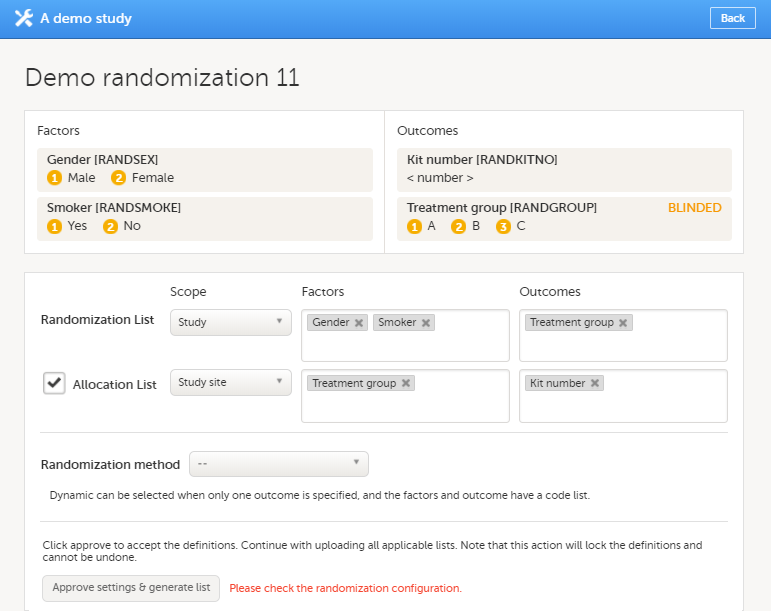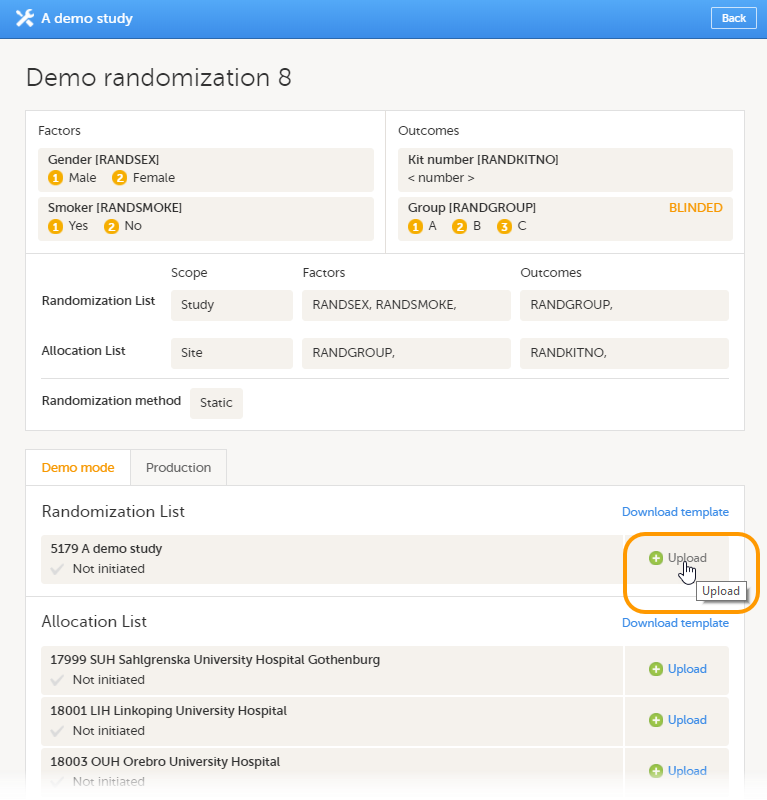Configuring a static randomization
This lesson describes how to configure a static randomization in Viedoc Admin.
Introduction
About the randomization service
Viedoc offers support for randomization. Subjects can be randomized using:
- static randomization: randomization based on a randomized list,
- dynamic randomization (Pocock and Simon): randomization based on an algorithm.
Dynamic randomization ensures a more even distribution of subjects across the treatment groups, with regard to prognostic factors that might influence the effect of treatment on the subjects.
The randomization in Viedoc is configured in a similar way for static and dynamic randomization. The main difference is that for static randomization, a list with outcomes (randomization numbers, treatment groups, and so on) - the randomization list - is created and uploaded by the user, while for dynamic randomization, an algorithm is used to assign subjects to a treatment group and the randomization list is created by the system.
It is possible to upload a separate allocation list that allocates an Investigational Product (IP) to the subject. When the subject is randomized, Viedoc informs the clinic user which IP should be given to the subject. The allocation list is most commonly used in double-blind studies. Uploading of the allocation list is done in a similar way for static and dynamic randomization.
Terminology
| Term | Definition |
|---|---|
| RTSM | Randomization and Trial Supply Management. |
| Blinded role | A role that does not know which treatment the subject is receiving. Most roles in a clinical trial should be blinded. |
| Unblinded Statistician |
A system role that can configure the randomization in Viedoc Admin. The Unblinded Statistician sees which subjects are assigned to which treatments, and should therefore not have any role in the study where he/she should not know this information. An Unblinded Statistician can never again work in a blinded role within that study. |
| Randomization list | A list for allocating subjects to treatments or groups. The randomization list shows all available slots in the randomization. When randomization has started (that is, when the first subject has been randomized), the randomization list also shows which subjects have been assigned to which treatment or group. |
| Allocation list | A list for allocating IP to subjects. The allocation list shows all available IPs. When randomization has started, the allocation list also shows which IPs have been assigned to which subjects. Advanced allocation can be set up and for this there are two options for the allocation list(s):
|
| Scope |
Defines the scope from which a randomization slot or an IP should be selected. One of the following scopes can be chosen:
|
| Factor (Prognostic factor) |
Items that might influence the effect of treatment on the subjects, and that are to be used as input when randomizing the subject. For example sex or age. Viedoc supports the use of drop-down lists, radio buttons, integer and free text data types as input items. |
| Outcome | Items to be populated by the randomization service, for example treatment group. |
| Blinded outcome | Items to be populated by the randomization service, that should remain blinded until after the subject has been unblinded or emergency unblinded for a specific subject. These items will not be visible for any user in the system, except for the Unblinded Statistician who can see them in Viedoc Admin, or until an emergency unblinding was performed (for details on how the emergency unblinding is performed in Viedoc Clinic, see Randomization, allocation and emergency unblinding). |
Workflow
Randomizations are configured in Viedoc Designer and Viedoc Admin, and executed in Viedoc Clinic. The schematic below depicts what different steps need to be taken, and which roles have permission to perform these steps, depending on the allocation configuration type as described below:
- Randomization, optionally together with allocation performed at the same time as the randomization within the same form. In this case the form is locked (and therefore not possible to be edited) after the randomization is performed in Viedoc Clinic.
The configuration workflow in this case looks as illustrated in the following image:

- Randomization, optionally together with advanced allocation allows you to set up the allocation in a more flexible way, including:
- Configuring individual forms for randomization and allocation, to keep the two steps separated in the study workflow
- The possibility to perform multiple allocations at different visits during the study
- The possibility to replace an already performed allocation with a new allocation
- The possibility to undo an already performed allocation
The configuration workflow in this case looks as illustrated in the following image:

This is a single-sourced file that should have the following content:
Introduction to randomization
Detailed instructions regarding these steps are described in:
- Setting up the randomization in Viedoc Designer
- Configuring a static randomizations in Viedoc Admin (this lesson!)
- Configuring a dynamic randomization in Viedoc Admin
An example of how to configure a dynamic randomization is described in detail in the following lesson:
For a video tutorial on how to configure a static list randomization and a dynamic randomization, see:
Study license and randomization
| Important! The randomization feature must be included in your study license in order for the randomization configuration to be available in production mode. You can still configure a randomization in demo mode without a license. |
On the randomization page, under the Demo mode tab, you can perform all the configuration actions, select the link to download the template (Excel file) for the randomization list, and upload a file with a randomization list or an allocation list.
If your study license has the randomization feature included, it will be shown on the Study settings page on the Settings tab under Included features:

If your study does not have a license key (Reference ID), or has a license key that does not include the randomization feature, on the randomization page, under the Production tab:
- A message is shown informing you that the randomization feature is not included in the license:
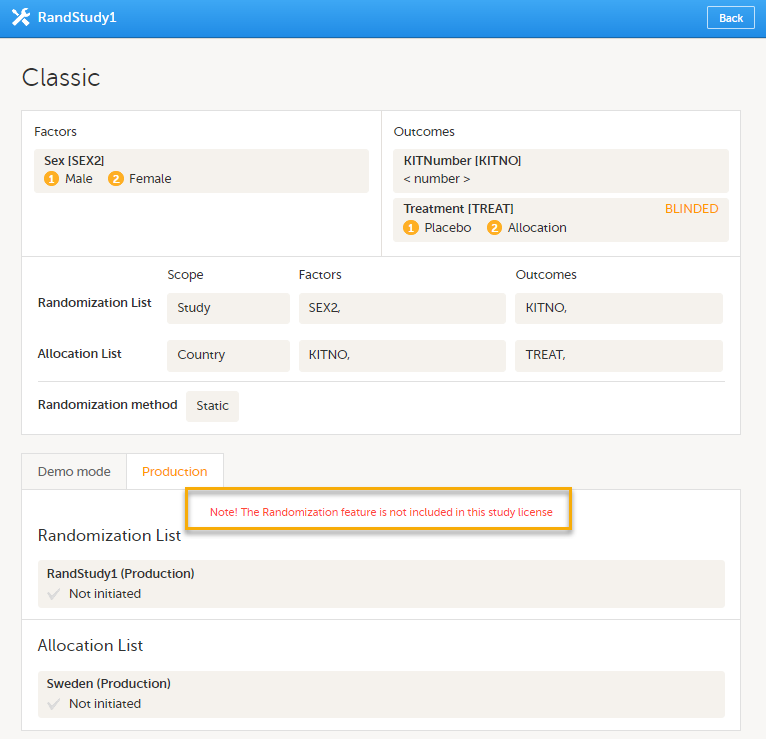
- The link to download the template (Excel file) for the randomization list is not available.
- It is not possible to to upload a file with a randomization list or an allocation list.
For more information about licensing, see Overview of Viedoc
Static randomization in Viedoc Admin
What is static randomization?
Static randomizations are based on randomized lists that are uploaded by the user. These lists should be generated by the user in advance to ensure that the allocation of subjects to treatments, and of Investigational Products (IP) to subjects, is random. When a subject is randomized, Viedoc assigns that subject to the next free slot in the list, which then decides the treatment the subject is to receive.
Description of the randomization page
Note! The randomization page is only visible for users with the role Unblinded Statistician.
Once the randomization mapping has been set up in Viedoc Designer, the RTSM field appears for users with the role Unblinded Statistician. When you click the toolbox icon in the RTSM field, the Randomizations pop-up opens. Here you can do the following:
1. Choose the type of the allocation list to be used:
- Individual allocation list - separate allocation lists for each of the randomizations in your study.
- Global allocation list - one global allocation list for all the randomizations in your study.
Note! To be able to use Logistics, a Global allocation list must be used.
2. View a list of randomizations that have been added to your study.
3. Open the Randomization page to configure the randomization or view the randomization details.

On the Randomization page, you can view or do the following:
4. View the items, and their code lists, that have been mapped as input factors.
5. View the items, and their code lists, that have been mapped as outcome and blinded outcome.
6. Set up the randomization list by defining:
- The scope of the randomization list. You can select one of the following options:
- Study
- Country
- Site
Note! If you set the scope to Country or Study site, a separate randomization list for each country or site will be created. In that case, you cannot use Country or Site respectively as input factor(s).
- The factors - only if the advanced allocation is not enabled in Viedoc Designer (see Setting up the randomization lesson in the Viedoc Designer User Guide for details on advanced allocation). If advanced allocation is enabled, then the factors are automatically populated from the settings in Viedoc Designer.
- The outcome - only if the advanced allocation is not enabled in Viedoc Designer (see Setting up the randomization lesson in the Viedoc Designer User Guide for details on advanced allocation). If advanced allocation is enabled, then the outcomes are automatically populated from the settings in Viedoc Designer.
7. Optional: set up the allocation list by defining:
- The scope of the allocation list. You can select one of the following options:
- Study
- Country
- Study site
Note! If you set the scope to Country or Study site, a separate allocation list for each country or site has to be uploaded.
- The factors - only if the advanced allocation is not enabled in Viedoc Designer (see Setting up the randomization lesson in the Viedoc Designer User Guide for details on advanced allocation). If advanced allocation is enabled, then the factors are automatically populated from the settings in Viedoc Designer.
- The outcomes - only if the advanced allocation is not enabled in Viedoc Designer (see Setting up the randomization lesson in the Viedoc Designer User Guide for details on advanced allocation). If advanced allocation is enabled, then the outcomes are automatically populated from the settings in Viedoc Designer.
8. Select the randomization method.
9-17. You can test the randomization in demo mode by uploading dummy randomization lists and dummy allocation lists to make sure everything works as expected before randomizing patients in production mode. Click the tab (9) to switch between demo mode and production mode.
10. View the details of the randomization list for the different scopes: the scope (in this example the study) and the status (Active, Inactive or Not initiated). In this field, you can upload the randomization list by clicking Upload (not visible in the image). Once a randomization list has been uploaded, icon 11 and 12 appear.
11. Download a template (Excel file) for the randomization list.
12. View the randomization list. An Excel file is downloaded. For a description of the randomization list, see The randomization list.
13. Edit the randomization list. You can select one of the two following options:
- Add to list - to upload a randomization list (Excel file) that adds slots to the existing randomization list.
- Upload a new list - to upload a randomization list (Excel file) that replaces the existing randomization list. The current list will then be inactivated. This will not affect already randomized subjects.
14. View the details of the allocation lists for the different scopes: the scope (in this example the sites, for each scope a different allocation list needs to be uploaded) and the status (Active, Inactive or Not initiated). In this field, you can upload the randomization list by clicking Upload. Once a randomization list has been uploaded, icon 15 and 16 appear.
15. Download a template (Excel file) for the allocation list.
16. View the allocation list. An Excel file is downloaded. For a description of the allocation list, see The allocation list.
17. Edit the allocation list here, if you selected to use Individual allocation list. You can select one of the two following options:
- Add to list - to upload an allocation list (Excel file) that adds slots to the existing allocation list.
- Upload a new list - to upload an allocation list (Excel file) that replaces the existing allocation list. The current list will then be inactivated. This will not affect already randomized subjects.
The numbers in front of the study name and site names in the Randomization List and Allocation List fields (5227, 18716, 18718, and 18951 in the image) are the study identification number and site identification numbers that are generated by the system and used for internal identification of study and sites.
The randomization list
A template randomization list customized for your randomization configuration can be downloaded by clicking Download template in the Randomization List field (see nr 11 in the image above). For the example shown in the image above, the template randomization list looks as follows:

The list shows the factors and outcomes. The Item IDs are displayed as column names, their code lists are displayed in the rows below. Every possible combination of factor(s) and outcome(s) is shown here. The randomization list that you should upload, should contain exactly these Item IDs as column names. It also should contain exactly these combinations of factor(s) and outcome(s), in a randomized manner. Each row represents a slot, the total number of rows in the randomization list equals the total number of slots.
Once the randomization is started, it is possible to view the active randomization list by clicking View in the Randomization List field (see nr 12 in the image above). An Excel file is downloaded that has the following sheets:
- Configuration - summarizes the factors and outcomes and their code lists configured for the randomization.
- Current distribution - displays the distribution of randomized subjects over the different factors and treatments.
- Slots - lists all the slots, the factors and outcomes, and whether the slot is still available. If the slot has been taken, the subject details, user details (e-mail address) of the clinic user who randomized the subject, and date and time of randomization are also displayed, see the image below.
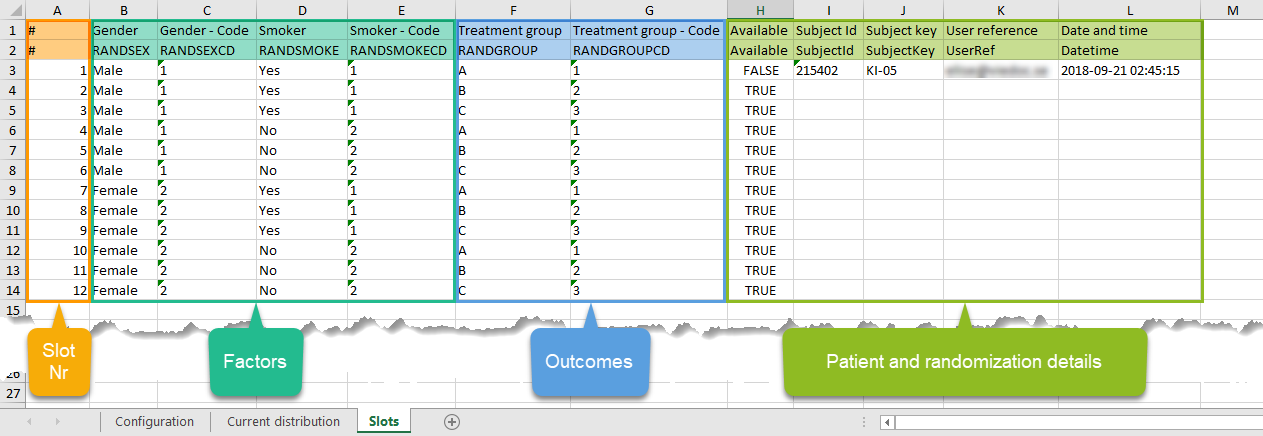
The allocation list
If allocation is activated, a file with available slots (kit numbers) should be uploaded for each scope (study, country or site), before the first allocation is performed.
A template allocation list customized for your randomization configuration can be downloaded by clicking Download template in the Allocation List field (see nr 15 in the image above). For the example shown in the image above, the template allocation list looks as follows:
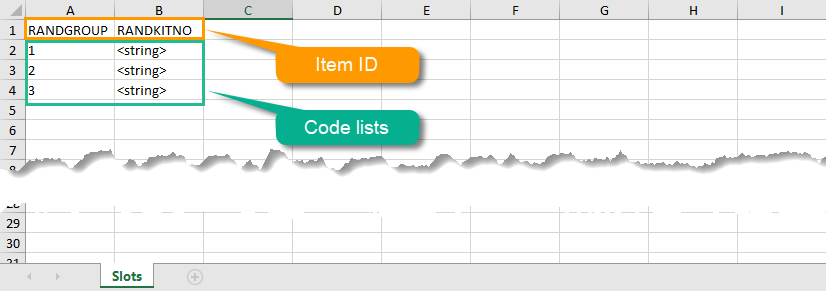
The list shows the factors and outcomes. The Item IDs are displayed as column names, their code lists are dispayed in the rows below. Every possible combination for the factors and outcomes is shown here. The item RANDKITNO (kit numbers) was configured to be a free text field, so the allocation list says <string>. A list of kit numbers has to be added to the file, before the template can be uploaded as allocation list, as in the example below:
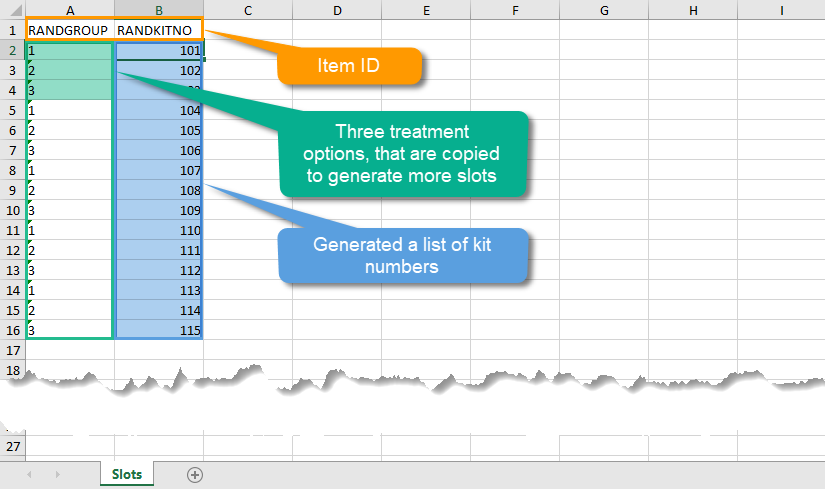
Once the randomization is started, it is possible to view the allocation list by clicking the view button in the Allocation List field (see nr 16 in the image above). An Excel file is downloaded that has the following sheets:
- Configuration - summarizes the factors and outcomes and their code lists configured for the randomization.
- Current distribution - displays the distribution of randomized patients over the different factors and groups.
- Slots - lists all the slots, the factors and outcomes (kit number in this case), and whether the slot is still available. If the slot has been taken, the subject details, the user details (e-mail address) of the clinic user who randomized the subject, and date and time of randomization are also displayed, see the image below.
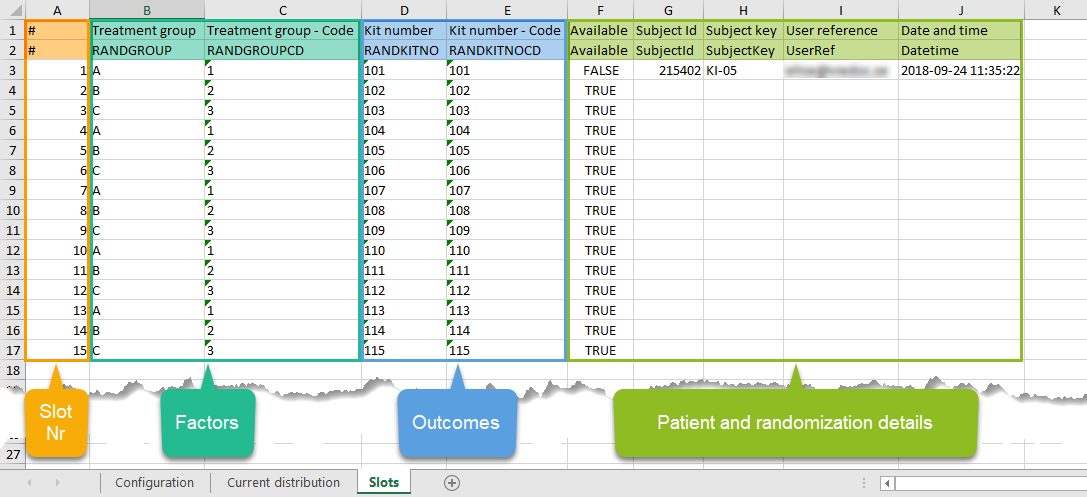
Step-by-step guides
Configuring a static randomization
Note! The randomization can only be configured by users that are assigned the system role Unblinded Statistician.
To configure the randomization, follow the steps below.
| 1 |
In Viedoc Admin, go to the study for which you would like to configure the randomization. In the RTSM field, click the toolbox icon to open the randomization window. |
| 2 |
Click Open to select the randomization you would like to configure. The Randomization configuration window opens as a pop up. This window also displays the prognostic factors and outcomes that have been defined in Viedoc Designer. |
| 3 |
In the Randomization List field, select:

|
| 4 |
If you want to use allocation, select the Allocation list checkbox, select the scope of the allocation list, and, only if advanced allocation is NOT enabled in Viedoc Designer, the input factors, and the desired outcome (for example, kit number). Based on the allocated treatment, a kit number will then be assigned to the subject. |
| 5 | From the Randomization method drop-down list, select Static randomization. |
| 6 |
Click Approve settings & generate list. |
Configuring a randomization list for static randomization
The randomization list initially indicates status Not initiated. A randomization list with the available slots for randomization should be uploaded to enable randomization.
Downloading a template randomization list
You can download a template slot list in Excel from Viedoc Admin, or you can create one yourself. To download the template slot list from Viedoc, click Download template.

Uploading a randomization list
To upload a randomization list, follow the steps below.
| 1 |
Click Upload. |
| 2 |
Select the file containing the slot list and click Open. The file will be uploaded. |
Viewing a randomization list
Once the randomization list has been uploaded, the status of the randomization will turn into Active. From that moment, the randomization list (displaying which slots are taken) can be downloaded in Excel format by clicking View.
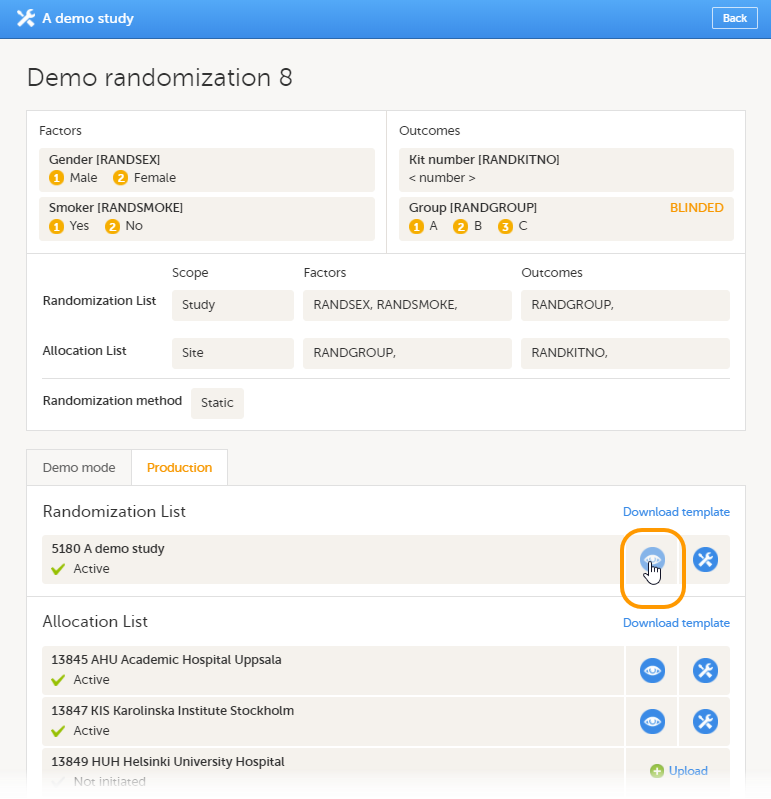
Editing a randomization list
To edit an active randomization list, follow the steps below.
| 1 | Click the toolbox icon.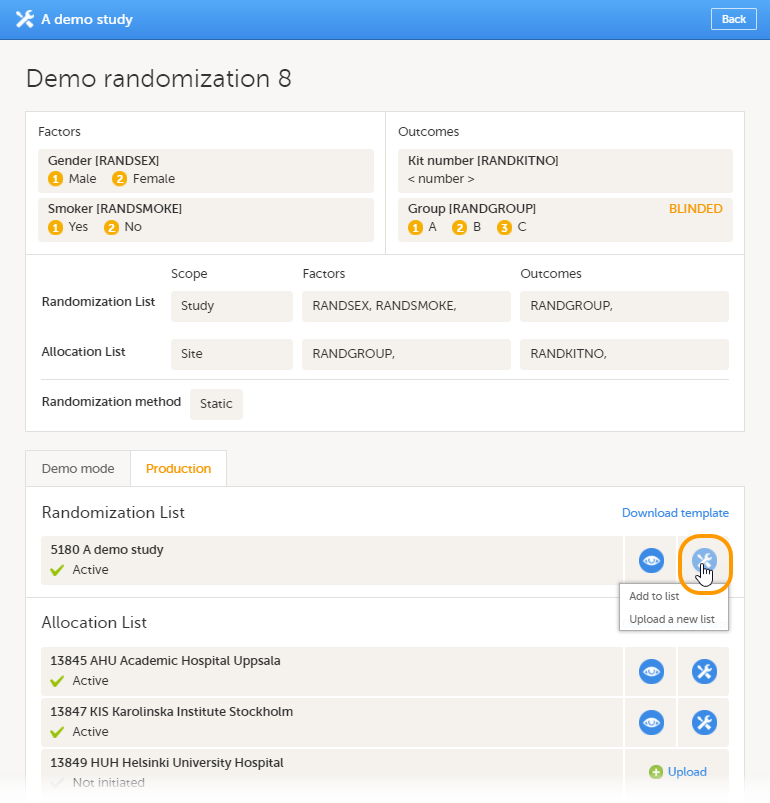 |
| 2 | Select: Add to list or Upload new list.
|
| 3 |
Select the file containing the slot list and click Open. |
Configuring the allocation list
There are two different options for the allocation list, as follows:
- Individual allocation list - separate allocation lists are used for each defined randomization. If the allocation list is not uploaded, the subject can be randomized in Viedoc Clinic, but no kit is allocated.
- Global allocation list - one global allocation list is used for all the defined randomizations. This is available only if advanced allocation is enabled in Viedoc Designer (for details on advanced allocation settings in Viedoc Designer, see Setting up the randomization lesson).
To be able to use Logistics, a Global allocation list must be used.
If the allocation list is not uploaded, or, in case of using Logistics, if no kits are available at the current defined scope (Study / Country / Study Site), when trying to perform the allocation in Viedoc Clinic, the system will respond with No slots found for allocation.
Setting up a Global allocation list is described in Configuring the Global allocation list.
This is set up under the RTSM settings in Viedoc Admin, as illustrated in the image below:
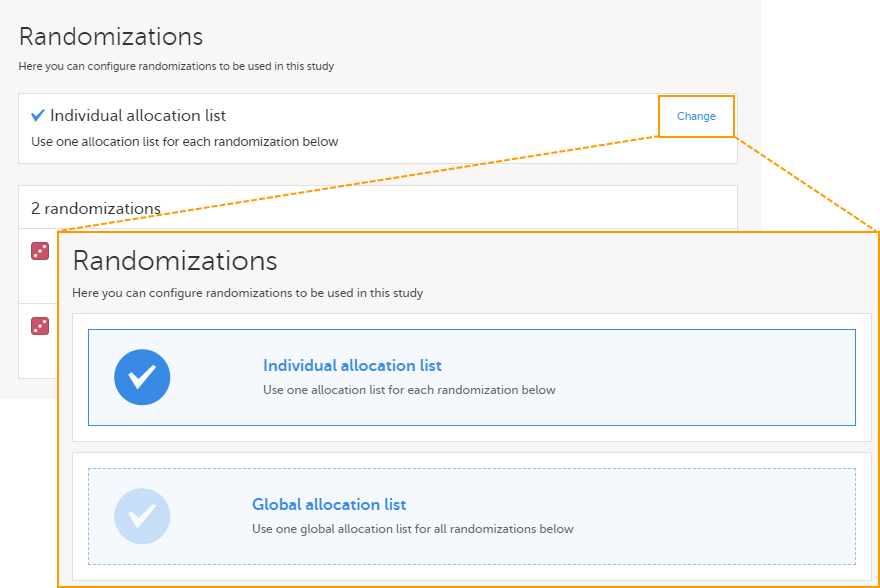
Individual allocation list
If individual allocation list(s) are used for each randomization, the allocation list will be uploaded separately for each defined randomization, as described below.
Downloading a template allocation list
You can download a template slot list in Excel from Viedoc Admin, or you can create one yourself. To download the template allocation list from Viedoc, click Download template.

Uploading an allocation list
For an example of the allocation list to be uploaded, see The allocation list.
To upload an allocation list, follow the steps below.
| 1 | Click Upload. |
| 2 | Select the file containing the slot list and click Open. The file will be uploaded. |
Viewing an allocation list
The allocation list can be viewed in a similar way as the randomization list, see Viewing a randomization list.
Editing an allocation list
The allocation list can be edited in a similar way as the randomization list, see Editing a randomization list.


